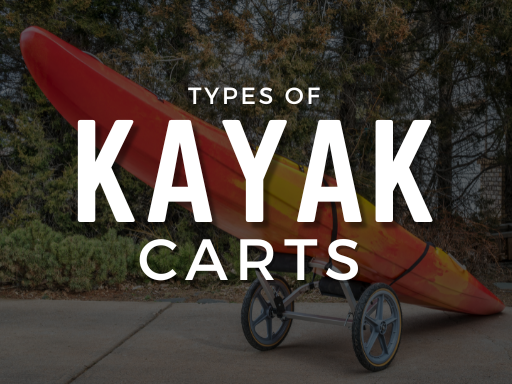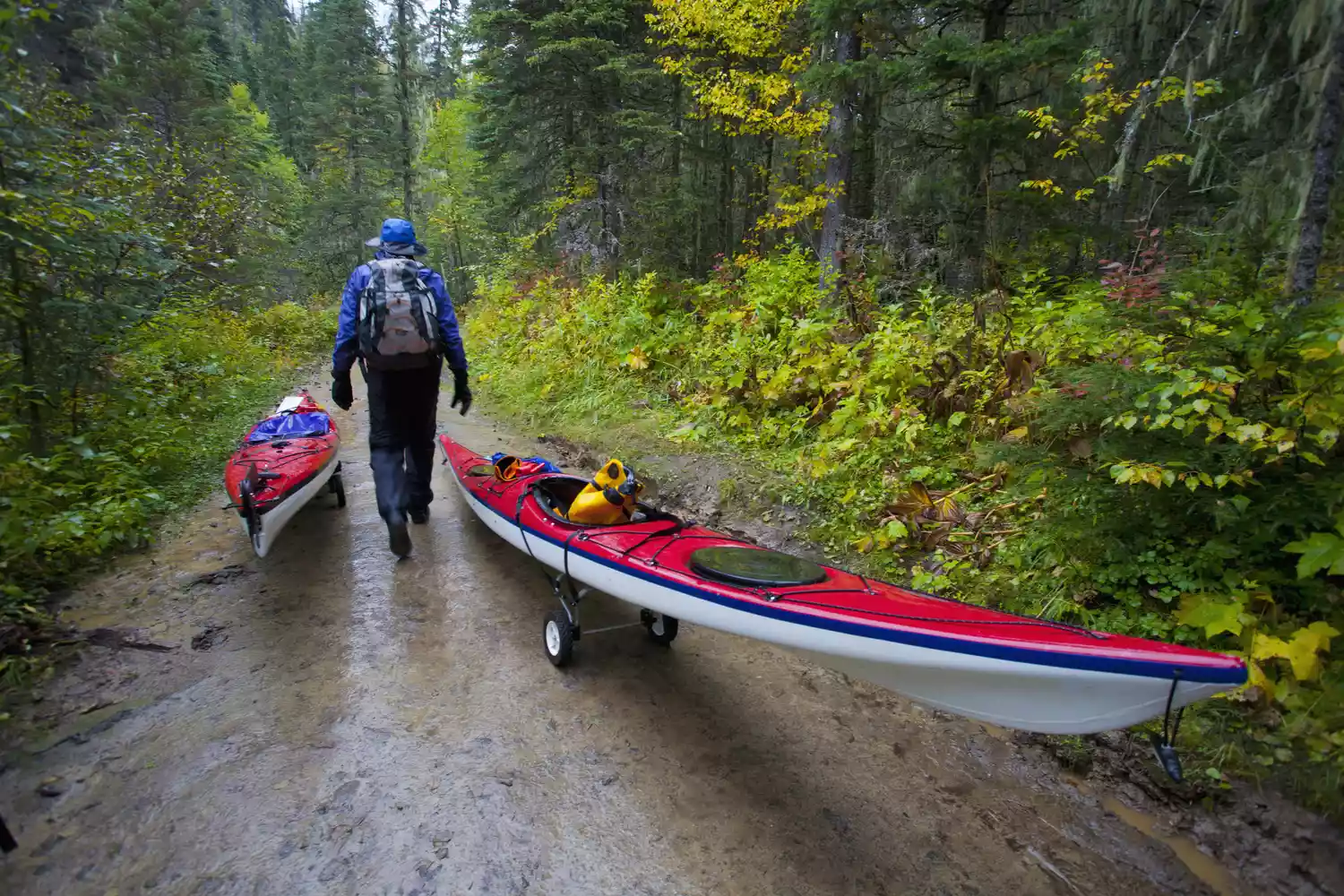Ever struggled with moving your kayak from your car to the water? Many face this issue. The solution is simple: learn how to use a kayak cart. This small but mighty tool makes transport a breeze. No more heavy lifting.
No more back pain. Just easy, smooth movement from point A to point B. In this guide, we’ll break down the steps. You’ll learn how to load, secure, and roll your kayak with ease.
So, let’s dive in. Your next kayaking adventure awaits, and it starts with mastering the kayak cart.
Key Takeaways:
- Kayak carts simplify transport and safeguard your kayak.
- Two main types: strap-style and plug-style carts, each with specific usage steps.
- They save energy, prevent kayak damage, and suit various kayaking needs.
What Is a Kayak Cart?
A kayak cart is your best friend for moving a kayak. It’s a simple tool. Two wheels, a frame, and straps. That’s it. But don’t let its simplicity fool you. This cart is a game-changer. Now, let’s dive into the details.
Transportation Aid
First up, the basics. A kayak cart helps you move your kayak. You don’t need a team to carry it. Just strap the kayak on the cart and roll. It’s that easy.
Fishing Kayaks
Love fishing? A kayak cart is a must. Fishing kayaks are heavy. They carry gear, bait, and sometimes a cooler. The cart makes it simple to move all that weight.
Solo Paddling
Paddling alone? No worries. The kayak cart is your solo helper. It allows you to move the kayak by yourself. No need for extra hands.
Protecting Your Kayak
Dragging a kayak can damage it. Scratches, dents, you name it. A kayak cart lifts the boat off the ground. This keeps it safe and sound.
Reducing Any Injuries
Lifting a kayak is hard work. It can hurt your back. A kayak cart takes away that risk. It does the heavy lifting for you.
Save Your Energy for Paddling
Kayaking is fun but tiring. Save your energy for the water. Let the kayak cart do the hard work on land.

Types of Kayak Carts & How to Use It?
Looking to move your kayak with ease? Knowing the types of kayak carts and how to use them is key. Let’s find out.
Strap Style Kayak Carts
Strap style kayak carts are popular and easy to use. They come with straps to secure your kayak. Ready to learn how to use one? Let’s get started.
Step 1: Set Your Cart Next to Your Kayak
First, place the cart close to your kayak. Make sure it’s on stable ground. This sets the stage for easy loading.
Step 2: Start at the Stern
Next, lift the stern of the kayak. Place it on the cart’s pads. This is where the kayak will rest.
Step 3: Bring the Bow into Line
Now, move to the front. Lift the bow and align it with the stern. Your kayak should sit straight on the cart.
Step 4: Check the Balance
Before strapping, check the balance. Make sure the kayak sits evenly. This prevents tipping during transport.
Step 5: Strap It In
Finally, use the straps. Secure them around the kayak and cart. Make sure they’re tight but not too tight. You’re all set.
Plug Style Kayak Carts
Plug style kayak carts are unique. They plug into the holes at the bottom of your kayak. Curious about how to use one? Let’s jump in.
Step 1: Grab Your Cart
First things first, have your cart ready. Keep it close to your kayak. This makes the next steps easier.
Step 2: Tip Your Kayak
Next, tip your kayak onto its side. This exposes the holes where the cart will plug in.
Step 3: Lift Your Cart
Now, lift the cart. Align its rods with the kayak’s holes. Then plug it in. Make sure it fits snugly.
Step 4: Turn Your Kayak Back Over
Time to flip your kayak back. Carefully turn it over so it sits on the cart. The cart should hold it securely.
Step 5: Check the Balance
Last step. Check the balance of your kayak on the cart. Make sure it’s even. This ensures a smooth ride to the water.
Benefits of Using a Kayak Cart
A kayak cart offers many benefits, making it a must-have for any kayaker.
- First, it saves you energy. Paddling is fun but tiring. Why is waste energy dragging a kayak? Use a cart and save your strength for the water.
- Next, it’s a back saver. Lifting a Heavy kayak can strain your back. A cart eliminates this risk. Just strap and roll. No lifting is needed. This makes it ideal for solo trips. You don’t need a team to move your kayak. The cart does the job.
- Third, it protects your kayak. Dragging it over rocks or sand can cause damage. A cart lifts it off the ground, keeping it safe. This extends the life of your kayak, saving you money in the long run.
- For fishing enthusiasts, a cart is a game-changer. Fishing kayaks carry a lot of gear. A cart makes it easy to transport everything. No multiple trips back and forth.
- Lastly, it’s versatile. Different types of carts suit different needs. Whether you have a fishing kayak or a lightweight one, there’s a cart for you.
So, make your kayaking life easier and more enjoyable.
FAQs
How Do You Strap a Kayak Trolley?
Strapping a kayak trolley is simple. Place your kayak on the trolley. Use the provided straps to secure it. Loop the straps around both the kayak and the trolley. Tighten them until snug but not too tight. Now, you’re set to move.
How Do You Store a C-Tug Trolley on a Kayak?
Storing a C-Tug trolley on a kayak is straightforward. Disassemble the trolley and place its parts in your kayak’s storage area. Some prefer to store it in a mesh bag for easier access. Make sure it’s secure to prevent it from falling out.
How Do You Make a Homemade Kayak Trolley?
Making a homemade kayak trolley requires PVC pipes, wheels, and straps. Cut the PVC to form the frame. Attach wheels to the bottom. Use straps to create secure points for the kayak. Test for balance and durability before using it on your kayak.
Final Words
Mastering how to use a kayak cart can revolutionize your kayaking experience. These versatile tools save energy, protect your kayak, and make solo trips a breeze.
Whether you prefer strap-style or plug-style carts, the steps are straightforward.
With the right cart, you’ll say goodbye to heavy lifting and hello to effortless transport. So, gear up, hit the water, and enjoy your kayaking adventures with ease.





[…] Unlock the Secrets: How to Use a Kayak Cart Like a Pro! Your Ultimate Guide to Effortless Kayak Transport. […]